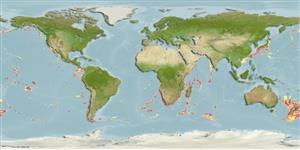Цельноголовые (химеры) (chimaeras) >
Chimaeriformes (Chimaeras) >
Rhinochimaeridae (Longnose chimaeras)
Etymology: Rhinochimaera: A chimaera with rhinos (Gr.), nose, referring to long, pointed proboscis of R. pacifica. (See ETYFish); africana: ana- (L.), belonging to: named for both its distribution around southern Africa and for the Sea Fisheries Research Institute research vessel Africana, from which holotype was collected. (See ETYFish).
Environment: milieu / climate zone / depth range / distribution range
экология
морской батидемерсальный; пределы глубины 549 - 1450 m (Ref. 11228). Deep-water
Southeast Atlantic: southern Africa and Mozambique Channel. Pacific Ocean: Japan (off Hokkaido and northern Honshu) to the east China Sea, including Taiwan; Costa Rica and Peru.
Size / Вес / Возраст
Maturity: Lm ? range ? - ? cm
Max length : 81.8 cm TL самец/пол неопределен; (Ref. 97389)
Краткое описание
морфология | морфометрия
This species is distinguished by the following characters: elongate body with an elongate, broad and paddle-shaped pointed snout extending anterior to head (SNL 47.7% HDL), tapering to a slender tail; the junction of supraorbital and infraorbital canals on ventral side of snout is closer to the tip of the snout than to the nasal canal; ONC/TIO is greater than 1.4 (ONC/TIO= 1.64); TIO/SWF is less than 1.5 (TIO/SWF= 1.47); TIO/LNC is less than 3.0 (TIO/LNC= 2.75); tooth-plates are nearly smooth; eyes are relatively small (EYL 6.4% BDL), distinctly behind level of mouth; the first and second dorsal fins are separated by a relatively long interdorsal space (IDS 23.6% BDL) and not connected by a web of skin; caudal-fin axis weakly raised with the fin asymmetrical, the epaxial caudal-fin lobe narrower than hypaxial lobe; dorsal caudal tubercles 25; caudal filament vestigial; coloration uniformly dark brown across entire body, except the oronasal region which is abruptly paler than the body (Ref. 97389).
Rare (Ref. 11228). Oviparous (Ref. 205). Eggs are encased in horny shells (Ref. 205).
Life cycle and mating behavior
половая зрелость | размножение | нерест | икра | Fecundity | личинки
Heemstra, P.C., 1995. Additions and corrections for the 1995 impression. p. v-xv. In M.M. Smith and P.C. Heemstra (eds.) Revised Edition of Smiths' Sea Fishes. Springer-Verlag, Berlin. (Ref. 11228)
Статус Красного Списка МСОП (Ref. 130435)
Угроза для людей
Harmless
Использование человеком
дополнительная информация
Возраст/РазмерыростЗависимость между длиной и массой телаЗависимость между длинамиРазмерный составморфометрияморфологияличинкидинамика численности личинокпополнениечисленностьBRUVS
ссылкиаквакультура (рыбоводство)особенности рыбоводствастепень растяжениягенетикаElectrophoresesнаследуемостьболезниобработкаNutrientsMass conversion
соавторыизображенияStamps, Coins Misc.звукиCiguateraскоростьтип плаванияжаберная областьOtolithsмозгзрение
инструменты
Специальные отчеты
Скачать в формате XML
ресурсы в Интернет
Estimates based on models
Preferred temperature (Ref.
123201): 2.1 - 8.2, mean 5.5 °C (based on 195 cells).
Phylogenetic diversity index (Ref.
82804): PD
50 = 0.6289 [Uniqueness, from 0.5 = low to 2.0 = high].
Bayesian length-weight: a=0.00195 (0.00083 - 0.00458), b=3.15 (2.95 - 3.35), in cm total length, based on LWR estimates for this (Sub)family-body shape (Ref.
93245).
Trophic level (Ref.
69278): 3.8 ±0.5 se; based on size and trophs of closest relatives
устойчивость к внешним воздействиям (Ref.
120179): низкий, минимальное время удвоения популяции 4.5-14 лет (Assuming Fec <100).
Fishing Vulnerability (Ref.
59153): Moderate to high vulnerability (53 of 100).
